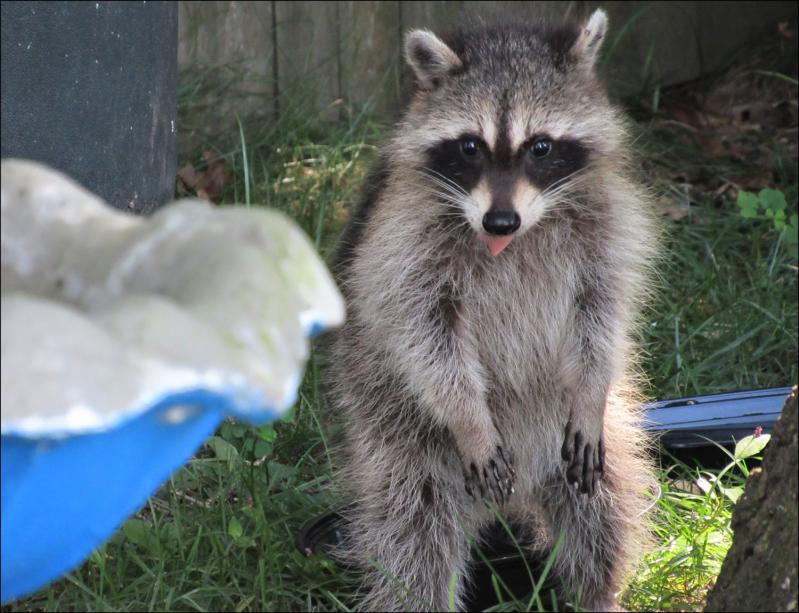It was a quiet, late summer day on Mill Hill Lane in East Hampton Village before the gunshot.
“There was lots of blood on the street,” said Richard Hodos, a village resident who called The Star, concerned and looking for answers. “The body was left there most of the day.”
Village cops had “dispatched,” or shot and killed, a sick raccoon.
For the first time since 2009, rabies has re-emerged on Long Island. Though in this case, “police said it wasn’t rabies, it was distemper,” said Mr. Hodos, who was worried about the safety of his dog. “The raccoons were acting strange, like they were drunk. Wobbling. They didn’t seem normal.”
The animal on the street was picked up by the Department of Public Works the next day. Another raccoon was dispatched at a construction site. “One of the construction guys threw it in his truck,” Mr. Hodos recalled.
Recent police reports show an uptick in raccoon encounters. There have been at least three other raccoon incidents in the village since Sept. 10. Two ended with dispatching, while one raccoon was whisked away to the Evelyn Alexander Wildlife Rescue Center in Hampton Bays.
“Basically, we get a raccoon every day or two,” Adrienne Gillespie, the center’s hospital supervisor, said.
On Sept. 16 in Sag Harbor Village, police cleared civilians away from a “possibly rabid” raccoon in front of Jack’s Stir Brew Coffee. They chased it down Washington Street and into the backyard of the Watchcase Factory condominiums. Deemed “too aggressive,” it was shot on the spot.
Turns out, there’s no special way to shoot a raccoon. “We shoot them with a service weapon,” said Jeffrey Erickson, the East Hampton Village chief of police. “We move them to a safe spot so as not to endanger the public. Sometimes we’ll bag them and take them away.”
Most, probably all, of these raccoons had distemper, according to Ms. Gillespie, but they’re rarely sent for testing, so no one knows for sure.
“Rabies and distemper can look similar,” she said. “Usually with rabies they’re more aggressive and they oversalivate, or foam at the mouth. When you capture them they tend to bite at whatever is around their mouths and they’re more vocal. With distemper they’re more lethargic and don’t put up a fight.”
Her center has had to euthanize over 250 this year alone.
“Distemper is 100-percent deadly. It’s always been bad for distemper and it gets worse and worse every year,” she said. “It’s just so contagious and prominent in raccoons, but we also see it in foxes. It can spread to dogs, though not to people.”
She won’t be surprised when rabies surfaces on the East End. “It’s getting closer and closer. There is no way to prevent it,” she said.
To slow or stop the spread, Suffolk County began distributing oral rabies vaccines earlier this month in Babylon, Huntington, Smithtown, and Islip.
According to a County Department of Health Services press release, the distribution “follows months of enhanced surveillance” in response to the reappearance of rabies. Distribution locations were selected to form a ring around the exposed areas, with the hope that rabies wouldn’t escape.
In addition, on Sept. 12, the county announced free rabies vaccinations for dogs, cats, and ferrets. By law, pets must be vaccinated, in part to prevent the disease from spreading to bats, which can randomly attack and transmit it to people. Each year, 3 to 6 percent of bats tested in Suffolk are found to carry rabies.
“The safety of our residents is of vital importance, which is why we launched the Suffolk County Raccoon Rabies Control Program pre-emptively,” County Executive Ed Romaine said in the release.
The county expects to distribute 250,000 baits, which are about the size of a ketchup packet. They’re coated with fishmeal, which should repel humans and pets but attract raccoons. Regardless, the county said most baits are eaten within four days and are relatively harmless. If your dog eats a lot of them, it may have an upset stomach. If your kid bites through one, there is a low risk of side effects from the vaccine, like rash, fever, or headache.
Fewer than 10 people die from rabies each year in the United States, largely because of effective treatment options. If bitten by an animal that potentially has rabies, immediate medical care is critical. A post-exposure series of rabies vaccines is nearly 100-percent effective.
Once severe symptoms appear, which, according to the Centers for Disease Control and Prevention, include “being very thirsty but panicked by fluids, having lots of saliva, and aggressive behavior like thrashing and biting,” the disease is almost always fatal.




